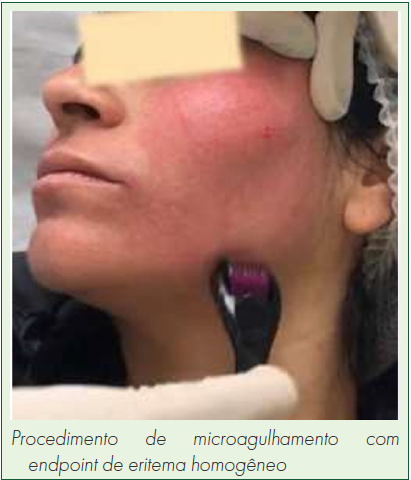Avaliação da eficácia do ácido tranexâmico em drug delivery através de microagulhamento no tratamento do melasma
Conteúdo do artigo principal
Resumo
Introdução: O melasma é um distúrbio de pigmentação da pele prevalente e de difícil tratamento. O ácido tranexâmico é agente potencial, mas há poucos estudos sobre sua eficácia pela via transdérmica (drug delivery).
Objetivo: Revisar a eficácia e perfil de segurança do ácido tranexâmico quando aplicado na forma de drug delivery através de microagulhamento no tratamento do melasma facial.
Métodos: Esta revisão colheu dados publicados em plataformas virtuais em português e inglês por busca através de descritores MESH/DeCS, com os termos: “melasma, ácido tranexâmico, drug delivery, microagulhamento” e em inglês “melasma, tranexamic acid, drug delivery, microneedling” com busca AND ou OR, pelo título ou resumo. Em seguida, considerando-se os de maior relação ao tema, foi lida a íntegra dos textos.
Resultado: Foram incluídos 24 artigos.
Conclusão: O ácido tranexâmico em drug delivery por meio de microagulhamento não se mostrou eficaz. No entanto, apresentou segurança clínica e tolerabilidade.
Detalhes do artigo

Este trabalho está licenciado sob uma licença Creative Commons Attribution 4.0 International License.
Referências
Handel AC, Miot LDB, Miot HA. Melasma: uma revisão clínica e epidemiologica. An Bras Dermatol. 2014;89(5):772-783.
Perper M, Eber AE, Fayne R, Verne SH, Magno RJ, Cervantes J, et al. Tranexamic acidic in the treatment of melasma: a review of the literature. Am J Clin Dermatol. 2017;18(3):373-381.
Cestari TF, Hexsel D, Viegas ML, Azulay L, Hassun K, Almeida ART, et al. Validation of a melasma quality of life questionnaire for Brazilian Portuguese language: the MelasQoL-BP study and improvement of QoL of melasma patients after triple combination therapy. Br J Dermatol. 2006;156(1):13-20. Doi: 10.1111/j.1365-2133.2006.07591.x
Balkrishnan R, McMichael AJ, Camacho FT, Saltzberg F, Housman TS, Grummer S, et al. Development and validation of a health-related quality of life instrument for women with melasma. Br J Dermatol. 2003;149:572-577. Doi: 10.1046/j.1365-2133.2003.05419.x
Pandya AG, Hynan LS, Bhore R, Riley FC, Guevara IL, Grimes P, et al. Reliability assessment and validation of the Melasma Area and Severity Index (MASI) and a new modified MASI scoring method. J Am Acad Dermatol. 2011;64:78-83. Doi: 10.1016/j.jaad.2009.10.051
Steiner D, Feola C, Bialeski N, Silva FA de ME, Antiori ACP, Addor FAS, et al. Estudo de avaliação da eficácia do ácido tranexâmico tópico e injetável no tratamento do melasma. Surg Cosm Dermatol. 2009;1(4):174-177.
Tse TW, Hui E. Tranexamic acid: an important adjuvant in the treatment of melasma. J Cosmet Dermatol. 2013;12(1):57-66.
Kim HJ, Moon SH, Cho SH, Lee JD, Kim HS. Efficacy and safety of tranexamic acid in melasma: a meta-analysis and systematic review. Acta Derm Venereol. 2017;97(4):1-6.
Lima EVA, Lima MA, Takano D. Microagulhamento: estudo experimental e classificação da injúria provocada. Surg Cosmet Dermatol. 2013;5(2):110-114.
Hou A, Cohen B, Haimovic A, Elbuluk N. Microneedling: a comprehensive review. Dermatol Surg. 2017;43(3):321-339.
Lima EA. Microagulhamento em melasma facial recalcitrante: uma série de 22 casos. An Bras Dermatol. 2015;90(6):917-919.
Jusuf NK, Putra IB, Mahdalena M. Is there a correlation between severity of melasma and quality of life. J Med Sci. 2019;7(1):2615-8.
Wang X, Li ZX, Zhang D, Li L, Sophie S. Um ensaio clínico duplo-cego, controlado com placebo, avaliando a eficácia e segurança de uma nova combinação de clareamento da pele em pacientes com cloasma. J Cosmet Dermatol Sci. 2014;4:92-98.
Pazyar N, Yaghoobi R, Zeynalie M, Vala S. Comparison of the efficacy of intradermal injected tranexamic acid vs hydroquinone cream in the treatment of melasma. Clin Cosmet Investig Dermatol. 2019;12:115-22. Doi: 10.2147/CCID.S191964
Kim EH, Kim YC, Lee ES, Kang YH. The vascular characteristics of melasma. J Dermatol Sci. 2007;46:111-6. Doi: 10.1016/j.jdermsci.2007.01.009
Hernández-Barrera R, Torres-Alvarez B, Castanedo-Cazares JP, Oros-Ovalle C, Moncada B. Solar elastosis and presence of mast cells as key features in the pathogenesis of melasma. Clin Exp Dermatol. 2018;33(3):305-8. Doi: 10.1111/j.1365-2230.2008.02724.x
Na JI, Choi SY, Yang SH, Choi HR, Kang HY, Park KC. Effect of tranexamic acid on melasma: A clinical trial with histological evaluation. J Eur Acad Dermatol Venereol. 2013;27:1035-1039.
Donnelly RF, Singh TRR, Woolfson AD. Microneedle-based drug delivery systems: Microfabrication, drug delivery, and safety. Drug Delivery. 2010;17(4):187-207.
Cassiano DP, Espósito ACC, Hassun KM, Lima EVA, Bagatin E, Miot HA. Early clinical and histological changes induced by microneedling in facial melasma: A pilot study. Indian J Dermatol Venereol Leprol. 2019;85(6):638-641.
Fabbrocini G, De Vita V, Fardella N, Pastore F, Annunziata MC, Monfrecola A, et al. Skin needling to enhance depigmenting serum penetration in the treatment of melasma. Plast Surg Int. 2011;2011:158241. Doi: 10.1155/2011/158241
Ismail ESA, Patsatsi A, Abd El-Maged WM, Nada EEAE. Efficacy of microneedling with topical vitamin C in the treatment of melasma. J Cosmet Dermatol. 2019;18(5):1342-1347.
Xu Y, Ma R, Juliandri J, Wang X, Xu B, Wang D, et al. Efficacy of functional microarray of microneedles combined with topical tranexamic acid for melasma: A randomized, self-controlled, split-face study. Medicine (Baltimore). 2017;96(19):6897. Doi: 10.1097/MD.0000000000006897
Menon A, Eram H, Kamath PR, Goel S, Babu AM. A split face comparative study of safety and efficacy of microneedling with tranexamic acid versus microneedling with vitamin c in the treatment of melasma. Indian Dermatol Online J. 2019;11(1):41-45.
Arida DKK, Rebellato PRO, de Campos GLM, Costa A, Schmitt JV, Skare TL, et al. Randomized, double-blind, placebo-controlled split-face trial of the efficacy of tranexamic acid by drug delivery through microneedling in the treatment of melasma. J Cosmet Dermatol. 2021;20(12):4005-4010. doi: 10.1111/jocd.14257.
Kertscher I, Takii FA, Noguchi JF, Raskin S, Ferrari LP, Mikami LR. Relevância do diagnóstico genético na identificação de variantes genéticas raras em duas famílias brasileiras com síndrome de Alport. BioSCIENCE. 2022;80(2):164-6. Doi: 10.55684/80.2.37










